How Panasonic Enhances Brand Loyalty with Maestra
How Panasonic Enhances Brand Loyalty with Maestra
More than a century ago the young Japanese entrepreneur Konosuke Matsushita set up his first workshop producing light sockets and other small electrical goods. His company grew to become what is known today as Panasonic Corporation, one of the world’s largest electronics manufacturers. Its vast product range includes consumer and professional electronics, household appliances and heavy-duty industrial solutions. As of 2018, Panasonic is placed at 231 in the Forbes Global 2000 list of major public companies.
Panasonic started retailing online in 2002, selling accessories at first before going on to sell household electronics and appliances. In 2014, Panasonic transferred its high-street sales to retail partners and focused on developing its direct online sales.
Panasonic’s online presence now includes its official online store and the Panasonic club for brand afficionados. Specialized product landing pages, social networks and mini-sites for competitions are also used to attract new customers.
Panasonic’s online marketing strategy has always been heavily influenced by the traditional family-owned Japanese appliance stores, some of which still operate today. The owners knew every one of their customers and remembered their personal preferences. Recreating this retail format in the modern Western high street would be problematic. But recreating it online is entirely feasible, using personalized communication to create the impression that Panasonic is your friendly local storekeeper.
In traditional Japanese stores, the shopkeepers know what appliances their customers have at home and make sure to order in new arrivals that will be of interest to them. They keep track of when their customers need to replace vacuum cleaner bags, air conditioner filters and even light bulbs. These shopkeepers are highly tuned to their customers’ wants and needs, and to a certain extent even anticipate them before they arise. These are the kind of local neighborly stores where you might just drop in for a chat on your way home from work. That’s the exact kind of atmosphere we wanted to create online with our personalization strategy. We strive to understand what our customers wants and needs are. If we can’t find out exactly what that is, we try hard to make our best guess.
To achieve this we needed a CRM marketing system that can store data and create segments for hundreds of thousands of customers and enable us to run a loyalty programme with direct communications. That’s how we came to work with Maestra.
What we achieved together
Panasonic uses two key indicators to measure marketing effectiveness.
KPI #1 is the percentage of new customers that make their first order after registering on the official Panasonic website, in the Panasonic club or on a promotional landing page.
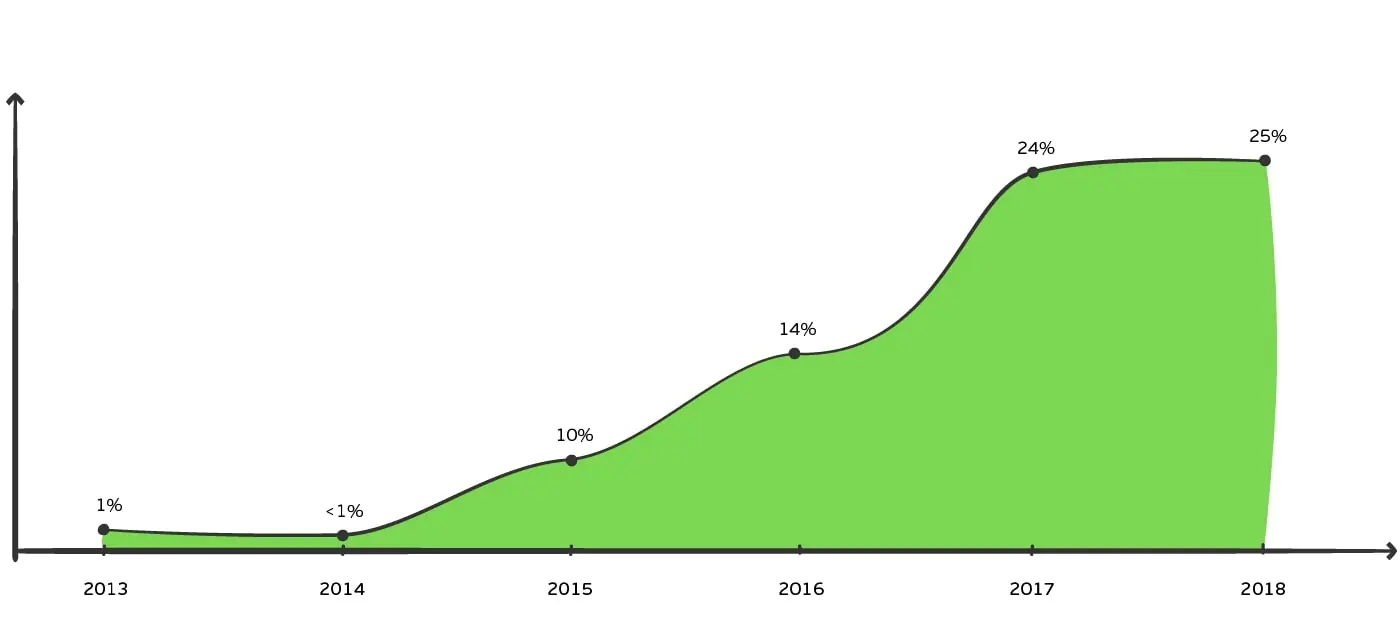
In 2014, only 1% of customers made their first order after registering online. In 2018, that indicator increased to 25%
KPI #2 is the ratio of registered vs. unregistered visitors interacting in some way with Panasonic’s online resources. This indicator shows the level of interest in the Panasonic brand and its activities.
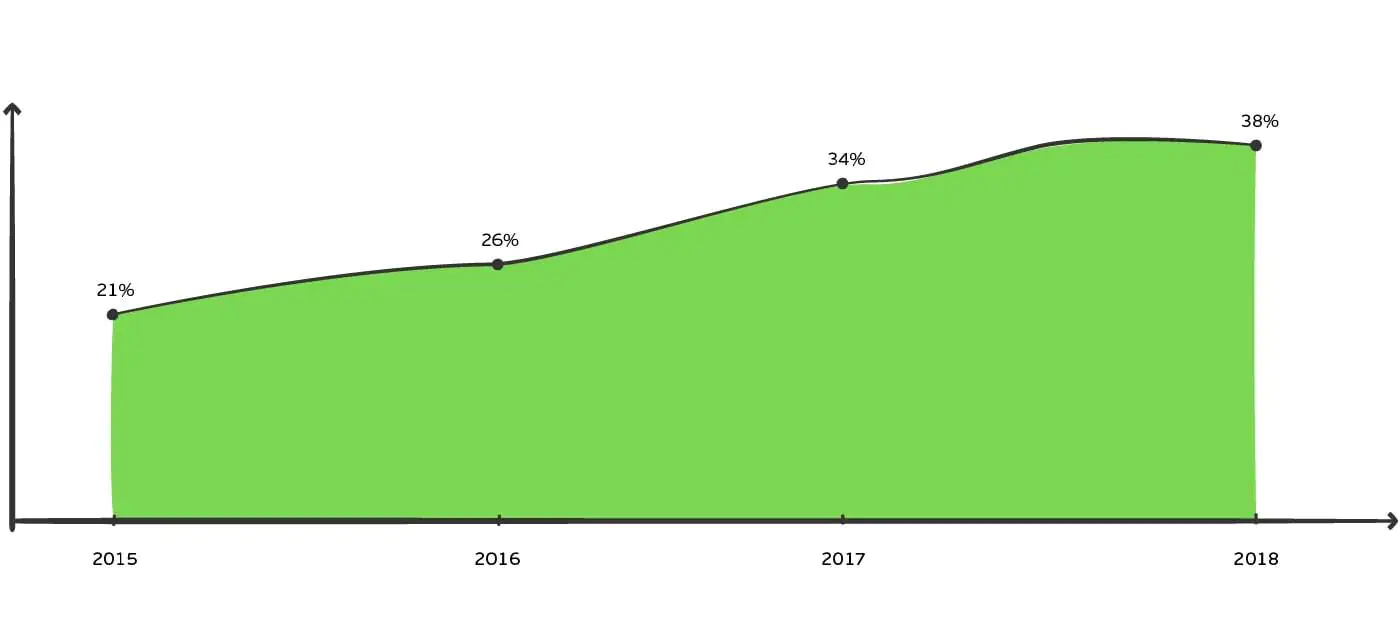
From 2015 to 2018 the number of active online visitors increased by 17%
What we’ve achieved so far:
- Created a unified customer database for generating personalized offers.
- Helped build a loyalty programme with three member tiers and a variety of bonus point campaigns.
- Set up unified registration for users of all Panasonic’s online resources.
- Helped set up a system to provide each customer with a personalized price for every product.
- Helped organise a joint loyalty programme with a major national bank and the JCB payment system, with special conditions for Panasonic customers.
Here’s how Panasonic uses Maestra to personalize its marketing.
All customer activity is stored in a unified database
In 2013 Panasonic’s customer data was spread across seven completely independent databases covering online retail, high-street retail, Cooking Club, Lumix Club and other channels.
It was impossible to get an accurate count of unique customers across all these databases, and compiling an overall picture of individual customers’ purchase history and behaviour was out of the question. There was no way the data could be used for any kind of personalized marketing.
At the core of the Maestra system is its CDP (Customer Data Platform). We used the CDP to compile the separate customer databases into one, merging behaviour, purchase and personal data. This gave us a clean database containing all available information about each and every customer.
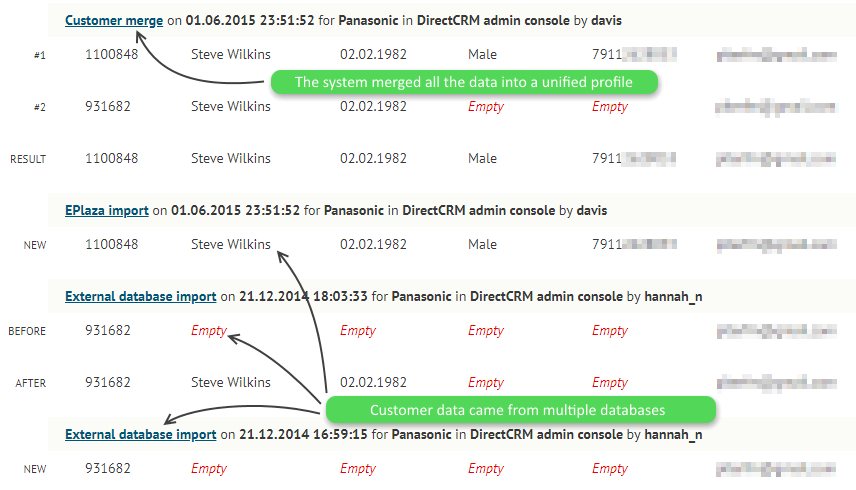
The CDP creates a detailed portrait of each individual customer. The data is complete, clean and easy to use.
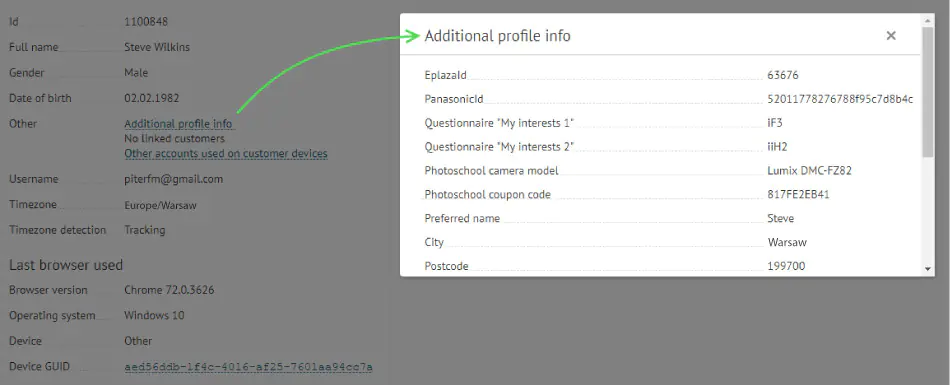
All customer data is accessible in the customer profile in Maestra
Maestra enabled us to create a unified database without duplicate entries and with no invalid or non-existent addresses. Together we ran a number of tests to see who did and did not respond to emails, and got our database into shape.
Panasonic uses Maestra to get to know its customers better. We connected all their online assets to Maestra — the online store, club websites and promotional landing pages — so that all data would be transferred to the unified customer profile in real time.
The result was a stark difference in customer profile completeness when compared to 2014:
2014
2018
Gender
40%
98%
Address
10%
37.5%
Gender and age simultaneously
0%
46%
Information in the unified customer profile allows marketers to segment their audience according to preferences and behaviour. Segmentation is needed in order to send automated campaigns only to customers who will be interested in them (and at the right time).
Panasonic has dozens of very specific automated campaigns, including abandoned views, abandoned carts, points expiry reminders, newsletters and other trigger workflows.
They have a variant in the “abandoned cart” workflow that uses bonus points. Customers receive temporary additional loyalty points to spend on their uncompleted order.
Previously they had standard triggered emails to remind customers to complete their orders. Customers were following the abandoned cart links but still not completing their orders, so the marketing team decided to change things around.
If an abandoned order is not completed with in a certain time, the customer receives temporary points that can be used for an additional discount on that order.
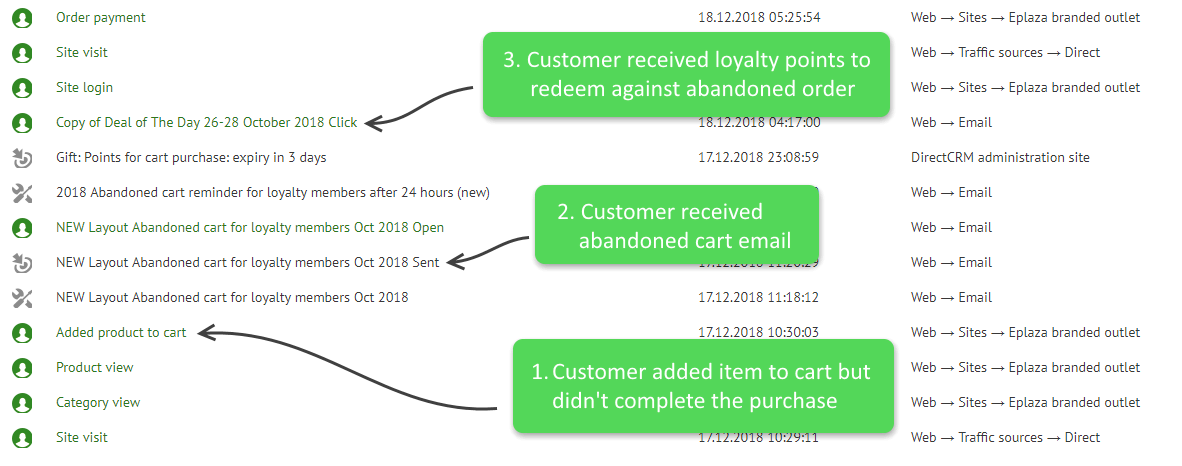
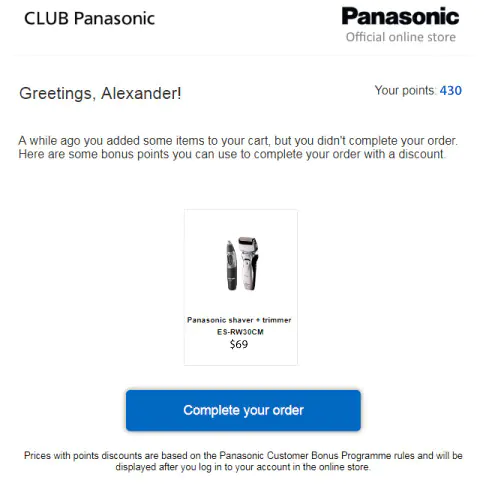
Customers have to follow a link in the email to find out how many points they can use in the order (they are logged in automatically)
The idea worked and in this example, the customer completed their order:
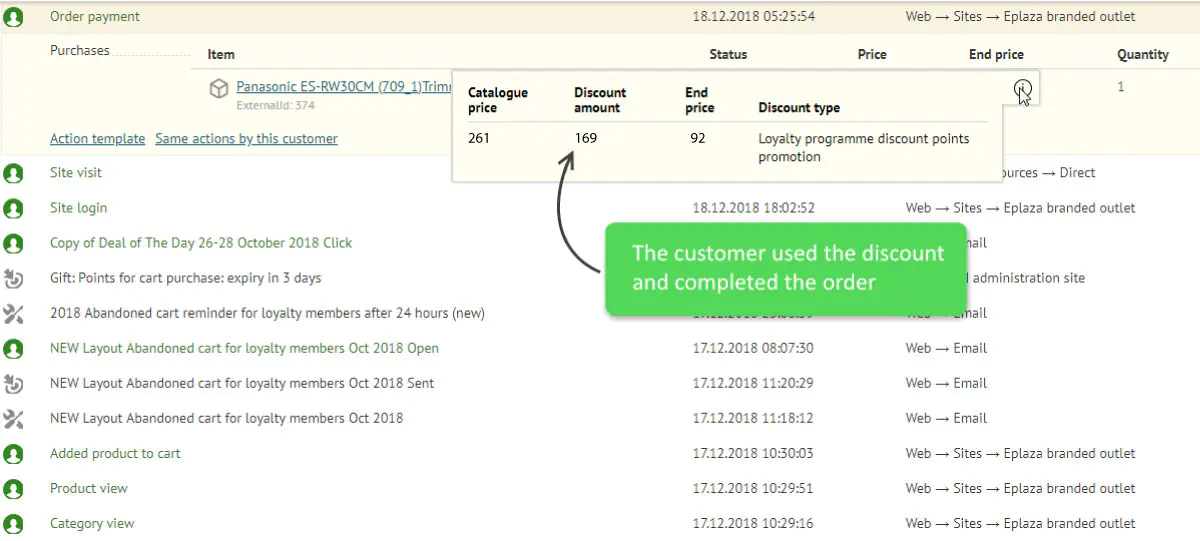
In total, between 25 and 30 triggers are running simultaneously. Triggers use segmentation data such as age, date of birth, gender and location.
For example, a reactivation email looks different for male and female recipients.
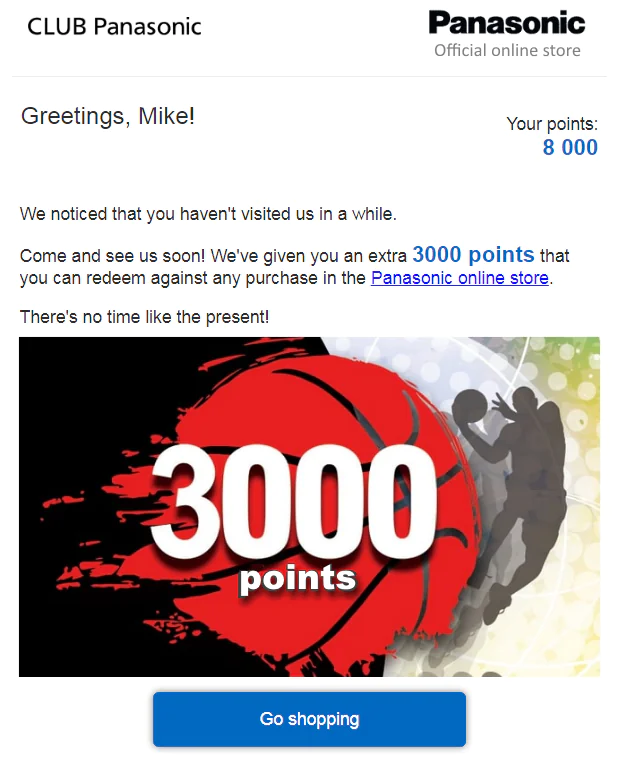

Panasonic also segments its bulk campaigns. Wishlists, for instance, are a valuable source of targeting information. If someone adds a kitchen appliance to their wishlist, they will receive discounts and offers on kitchen appliances. Someone with a camera in their wishlist will receive an email with photography promotions.
Here’s an example where a customer added a charger for a very specific type of batteries to her wishlist.

This action results in her inclusion in a battery discount promotion. She receives an email with an offer to use either a discount code or to use loyalty points to pay for up to 50% of her purchase.

The customer followed the link in the email and added batteries to her cart.
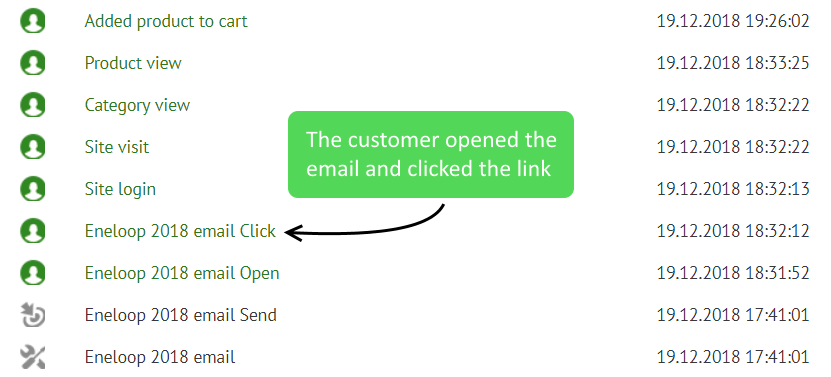
And completed her purchase.
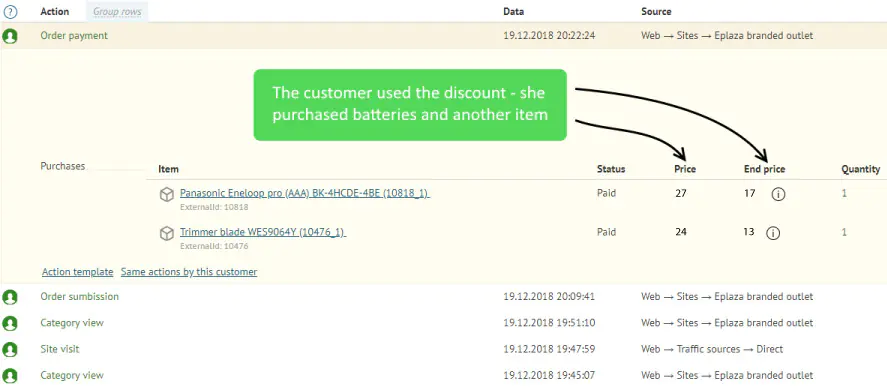
After creating a unified profile for all our customers, we set to work together with Maestra on improving our database and increasing its business value. We know that personalized email communications are a powerful marketing tool.
Personalized prices for loyalty program members
Up until 2012, Panasonic had a major advantage of brand recognition over other online retailers. People were wary of buying from unkown stores for fear of receiving counterfeit goods and tended to prefer purchasing directly from manufacturers’ branded outlets. Gradually, however, trust in independent online retailers began to grow. Panasonic responded to this change in market conditions by introducing a loyalty program.
Since then this loyalty program has gone through a number of iterations to become what it is today, with individual prices for every customer. If there are no special conditions or promotions, individual discounts can be up to 50% depending on how many points the customer has accumulated.
The exact discount is calculated in Maestra according to a formula specified by Panasonic.
Any customer that is logged in and does not have a corporate account sees two prices for every item in the catalog:
- Discounted personal price if they make a purchase with the loyalty points they have available
- Full retail price.
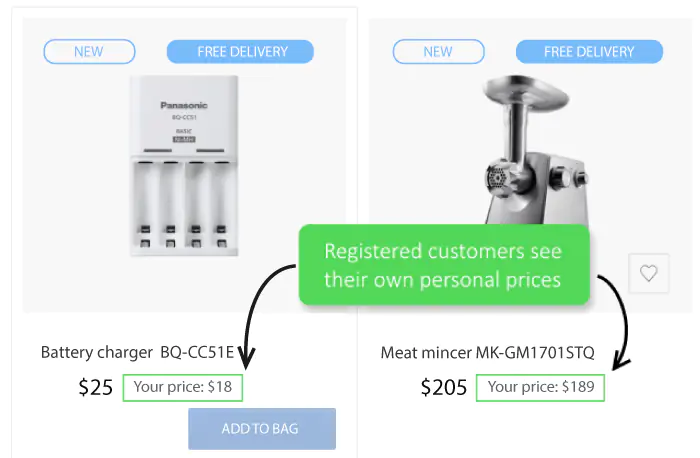
Prices in the online store are automatically calculated for each customer depending on how many points they have; discounts can reach up to 50%
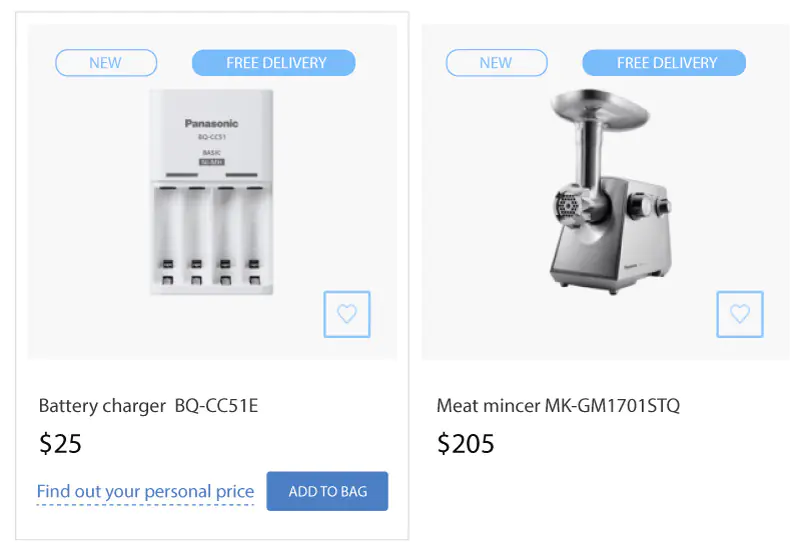
Customers that are not registered or not logged in don’t see the special discounted prices
Customers can easily see how many points they will be awarded with the purchase of any item. Individual prices for each product are based on how many points the customer has accumulated, their loyalty program status and on the number of points that will be awarded for the purchase of that product. All of this information is sourced from Maestra.
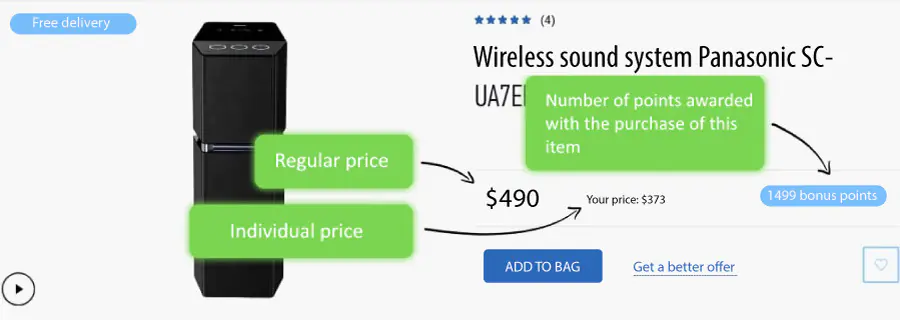
Single sign-on for all of Panasonic’s online resources
Panasonic runs short- and long-term campaigns on various online assets. Visitors arrive at different websites and landing pages from a wide variety of ads. Previously, this led to confusion, as users created separate accounts on each website, or registered on some websites but not on others. Consolidating their information was a complex undertaking.
Panasonic decided to simplify matters with a single sign-on for all online assets. In other words, users would have just one username and password for all of Panasonic’s online resources.
Maestra set up a single sign-on hub for Panasonic’s user club, online store, promotional landing pages and competition mini-sites.
Single sign-on (SSO) is an industry standard for corporate web resources. A customer who is registered on one website can freely roam on other websites without having to create new user accounts. Maestra is the central database for collecting customer data. We take care of registration and authorization, password recovery and deduplication of user data across all Panasonic’s sites.
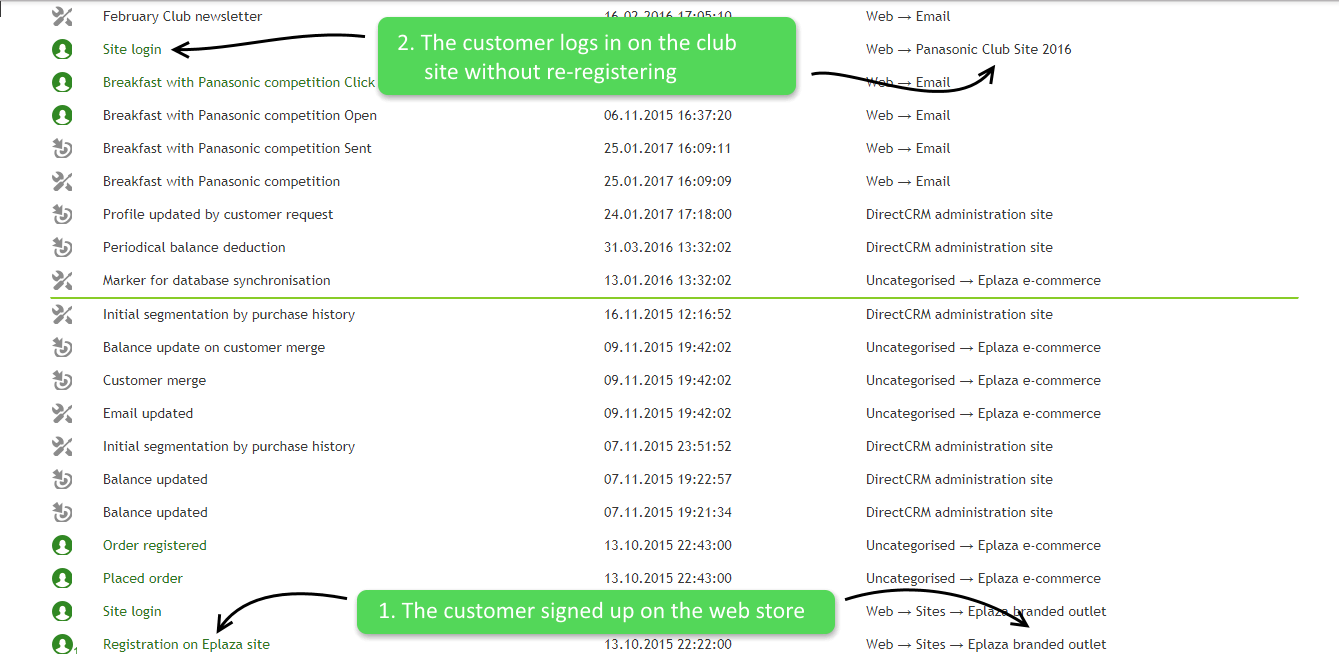
Customer activity across all online assets is collected in the unified customer profile. The online store provides data about product views, purchases and engagement in promotions, while the club website provides information about interests, preferences and brand engagement.
More ways to earn points
Every loyalty programme member can receive a discount of up to 50% depending on how many points they have. However, accumulating points from purchases alone is a slow process. Panasonic came up with a scheme that would encourage greater brand engagement and enable active customers to collect more points faster and deployed it on the Maestra platform.
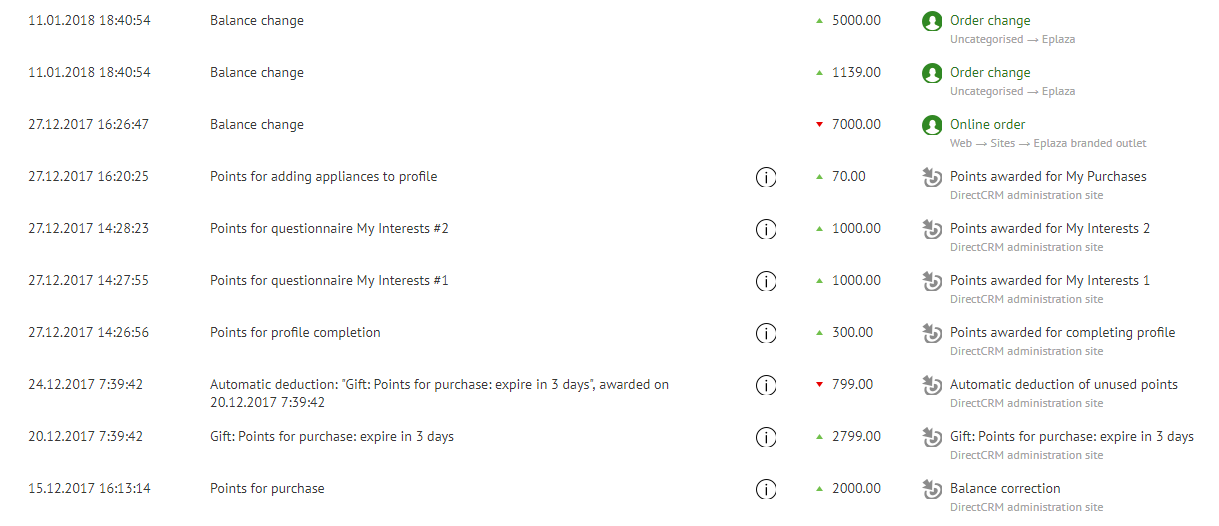
Points transactions are recorded in the customer profile in Maestra. Customers receive points for various activities, such as making purchases or filling out questionnaires, and can redeem their points when making purchases.
Points for customer details
Every customer receives an automated welcome email when they register a user account. In this email, Panasonic invites them to earn points by providing information about themselves and their preferences.
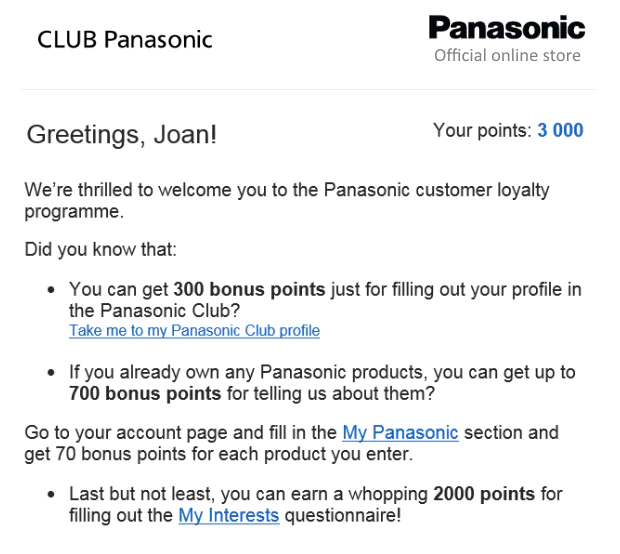
The Panasonic welcome email shows the customer how many points they can earn for providing different types of information
All profile information is passed to Maestra and is used in creating new marketing hypotheses and for planning triggered campaigns such as interest-based news digests and birthday emails.
Points for purchases
The number of points awarded for a purchase depend on the customer’s status in the loyalty programme at the time of purchase.
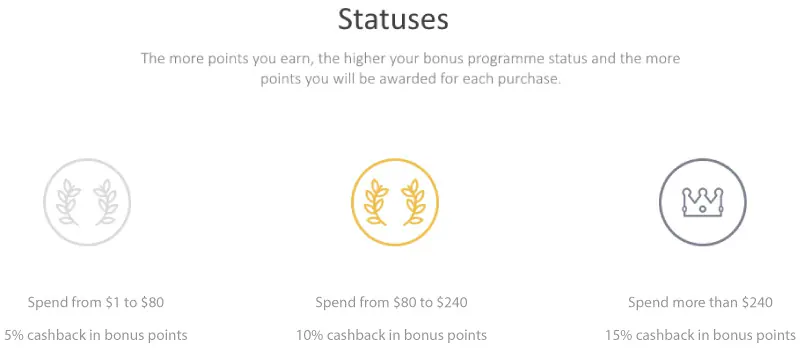
Silver members receive 5% of the purchase price in points. Gold members receive 10%. Premium members receive 15%
The online store passes information to Maestra where purchase amounts are calculated and customers are transitioned between segments.

Customers receive an email when their loyalty program status changes.
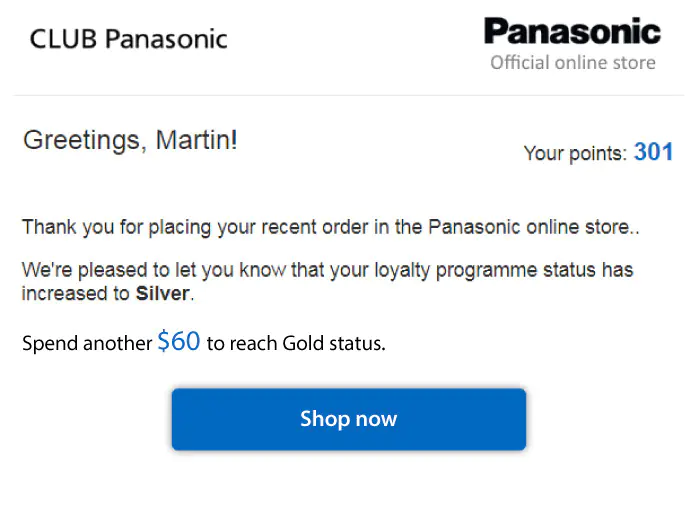
For some promotional items, a fixed number of points (up to 30%) may be awarded regardless of the customer’s loyalty program status. This means that customers in the 5% tier who spend all their welcome points on their first purchase can potentially get a 30% discount on their second purchase.
Engagement with the brand online
In 2018 Panasonic ran a major competition to mark its 100-year anniversary. First prize was a trip to Japan. Certificates for 5,000 and 10,000 bonus points were used as additional prizes at all stages of the competition. In December, Panasonic reminded its subscribers about the anniversary and offered extra points for sharing a post about it in social networks. This resulted in 3,000 reposts in three days.
Each promotion in Maestra can be fine-tuned to make it truly unique, allowing you to specify how often, for what actions and with what frequency you’d like to reward each user.
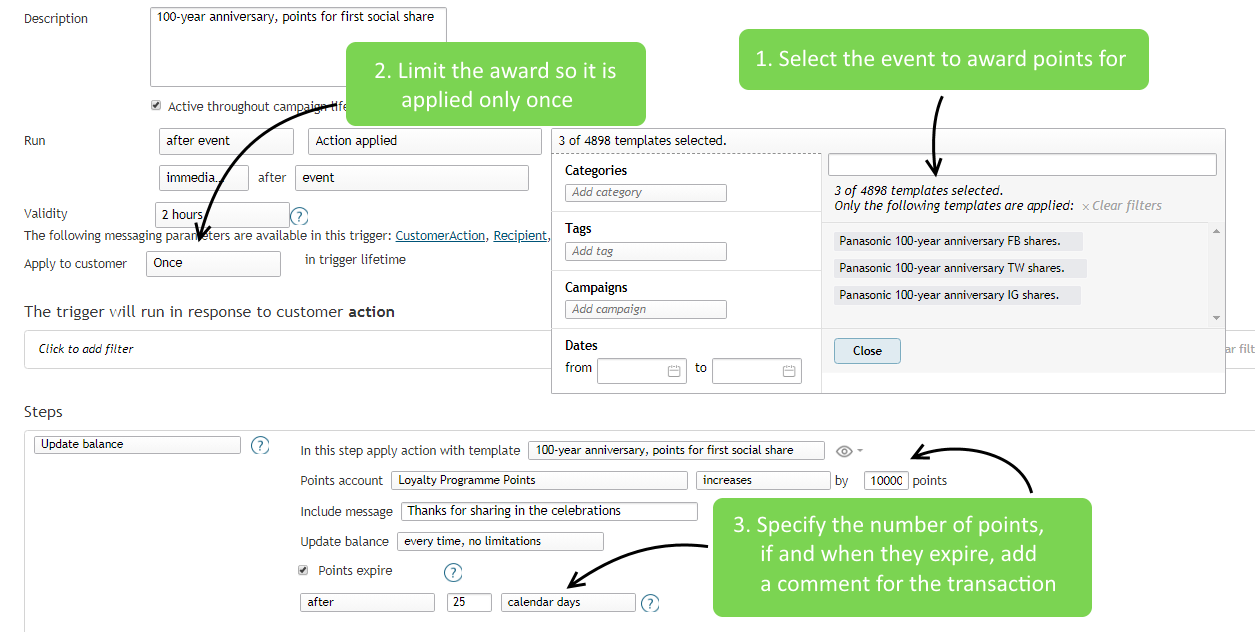
Promotion configuration in Maestra
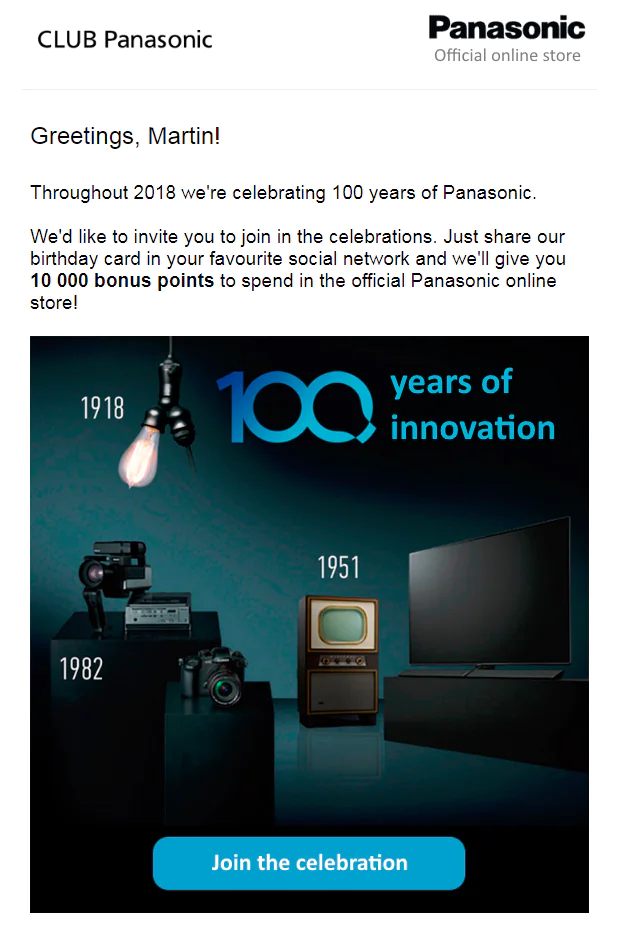
Promotional email
Another way to earn points is by writing a review on the official Panasonic website. This will net the customer 500 points. Prior to introducing this scheme, customers wrote from 5 to 10 reviews per month. Now they submit 5 to 10 reviews per day.
Use our partners’ bank card when making a purchase
Customers can receive extra points by paying for their purchases with a specific bank card. These cards work on the Japanese JCB payment system.
When a customer pays for any purchase (e.g. in supermarkets, cafes, filling stations) with this card, they get 5% cashback in their Club Panasonic account. Customers can accumulate loyalty points to redeem when purchasing Panasonic products simply by using their bank card every day. Cardholders also receive an additional 20% for purchases from the official Panasonic online store. This 20% combines with the standard loyalty programme rewards (5%, 10% and 15%, depending on the member’s tier). Premium members can thus receive up to 35% in bonus points. After making one large purchase, they can easily make several more purchases with the maximum available discount.
In addition, customers benefit from a wide range of privileges offered by the JCB payment system worldwide. JCB created a “Welcome to Japan” programme for tourists, with discounts on public transport, restaurants and tickets to major tourist attractions all over the country. Card holders also benefit from special discounts and privileges in other popular holiday destinations, including Thailand, Vietnam and South Korea. In Russia there is a “Made in Japan” programme for JCB customers that provides discounts in participating Japanese restaurants and retail outlets.
The partnership between Panasonic and JCB provides significant exposure for both companies. Being new in the region, JCB approached Panasonic with its partnership proposal. Aligning itself with a well-established Japanese brand in was a good opportunity for JCB to achieve recognition in the crowded payment systems sector.
Awarding loyalty points to cardholders required that we integrate Maestra with the bank’s systems. The bank passes information on a daily basis about how many points to award to whom. Customers can earn points from their bank before they ever register in the Panasonic system, so Maestra creates temporary accounts for them. When one of those customers registers in the Panasonic system, points are transferred from their temporary account to their loyalty program account.
The co-branded Panasonic 100-year anniversary JCB card was released in July 2018. By the end of 2018 around 1000 card holders had registered in our system. There are another 6000 cards in use, so we’re waiting for them to register with us. To date, registered card holders have made purchases totalling $60,000. The whole co-branding endeavour is mostly a PR project for us, with an added opportunity for enthusiasts to further engage with our brand. We never expected it to generate any significant additional revenue, so we see this as a pleasant bonus.
Over the lifetime of the loyalty program, 48% of Panasonic customers have used bonus points when making purchases.
In summary
In personaliing their communications, Panasonic pursued the goal of fostering a friendly relationship with its customers. Together with Maestra, Panasonic achieved this goal by:
- Creating a single customer database to get to know their customers better and to better personalize communications.
- Setting up a loyalty program with personalized prices for every member, and a variety of ways in which to earn points.
Thanks to these efforts, the number of people making their first order after registering on a Panasonic website grew from 1% in 2014 to 25% in 2018. The percentage of visitors engaging with Panasonic’s online assets also grew from 21% in 2015 to 38% in 2018.
In 2019, Panasonic plans to focus on analyzing the effectiveness and profitability of various user registration sources in order to have a better understanding of how different channels work, such as social networks and contextual advertisements.
In addition, they plan to increase the level of personalization offered by:
- Integrating their customer database with their call center so that customer information will be available to operators — for example what appliances the customer already owns.
- Enhancing triggered email campaigns using information about product price categories and regional demographics.
- Adding website push notifications to gather further information about customers.
Other plans include stepping up marketing and advertising activities, creating a dynamic website that builds itself for each customer with a selection of relevant items, and creating modules for each advertising campaign.
Testimonials
We now have automated routines in place that would have been impossible before we switched to Maestra. With each new automation, we tend to go through two stages. Once the task has been formulated we go through a difficult phase, sometimes with manual involvement. Then it gets more automated and simplified, with less manual supervision needed to get the intended results.
Now things are getting more interesting and complicated, because we have such a wide range of new possibilities. There’s always something new that we want to implement. Maestra provides even more functionality than we need.
I really like how the Maestra team always responds to all our enquiries. Depending on what we’re asking, the response might be an explanation or a suggested solution, or a detailed reason as to why our question needs to be addressed elsewhere. Most importantly, they’ve done everything that we set out to do with the platform.
I would recommend Maestra above all to anyone involved in online retail or other online business. It has extensive capabilities for tracking user behaviour. I would especially recommend it to companies with limited human resources. With Maestra, a single person can run an entire company’s marketing activities, and that person doesn’t even need to be particularly tech-savvy.
We’ve been working with Maestra for more than five years now. That’s quite a long time, and I’d say that it’s indicative of the level of reliability and service we receive, of Maestra’s understanding of our requirements and tasks and the team’s fast response to our requests. I would emphasise here that all our contacts at Maestra are very fast to respond. They’re great to work with, they’re always ready to go the extra mile, and to go above and beyond the original agreed scope of a task when need be. And they’re always thinking ahead on our behalf, sometimes this is really important.
I would recommend Maestra to anyone who wants professional, expert service, who wants to improve on their own CRM system, build relationships with their end users and develop their business.


